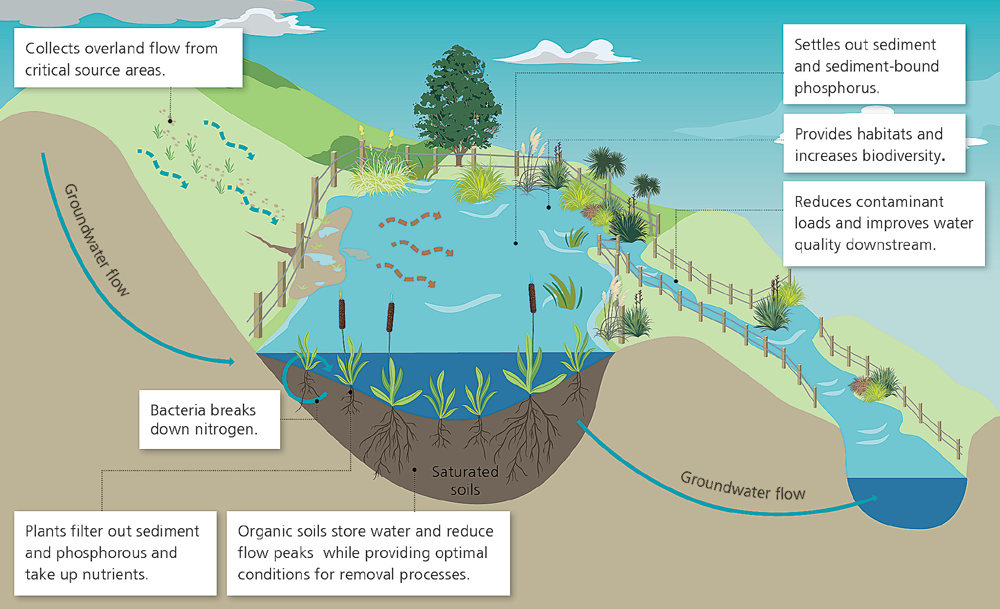Waikato dairy effluent breaches lead to $108,000 in fines
Two farmers and two farming companies were recently convicted and fined a total of $108,000 for environmental offending.
In managing contaminants on your farm, part of the solution might be right under your nose. DairyNZ environment manager Dr David Burger explains.
Bogs, swamps and seeps: these permanent or seasonally wet areas can all be classed as wetlands.
Historically, farmers have drained these wet areas to make their farms more productive but we now know that wetlands can play an important part in reducing our environmental footprint. In short, the benefits of protecting wetlands can outweigh those of gaining extra grazing space.
How wetlands work
Throughout New Zealand, wetlands support the greatest concentration of plants of any natural habitat. They help reduce flooding by acting as a sponge and improve water quality by trapping, filtering and removing contaminants, especially sediment, nitrogen and phosphorus. Protecting, restoring and creating these wetland ecosystems onfarm helps improve downstream water quality.
What is a wetland?
The three most common wetland types on dairy farms are seeps, wet or boggy places in paddocks, and wet areas beside riparian margins. You can recognise them by their location; they are easy to spot when you know what to look for.
Seeps occur at the bottom of hill slopes where groundwater comes to the surface. Seeps can be permanent or seasonal and exist on all soil types.
Wet areas in paddocks are swampy or boggy places where drainage is poor, such as hollows or valley bottoms. These areas could be fed by rainfall or a high water table, and tend to be on heavier soils.
Riparian wetlands are wet or boggy places bordering a waterway.
Whichever kind of wetlands you’re dealing with, managing them more effectively can offer animal welfare benefits and reduce the risk of stock getting stuck. Many farmers find the most satisfying part of managing wetlands is the resulting natural beauty and increase in biodiversity onfarm, particularly birdlife but also native fish and aquatic insects. 
How to manage a wetland
In looking after wetlands, your aim should be to get them to a stage where they can look after themselves with little input from you.
The steps to achieve this are the same for all three wetland types:
Make a plan by using DairyNZ’s Riparian Planner at dairynz.co.nz/riparian-planner.
Keep stock out by fencing.
Don’t drain wetlands; instead ensure their natural hydrology is maintained.
Identify weed and animal pests and control as appropriate.
Plant natives to suppress weeds and to increase biodiversity.
Take advice and keep it legal
If you want to restore or protect a wetland and it involves moving dirt or damming water, you may need consent. Always contact your local regional council or rural professional for advice and assistance. They can help you prepare a wetland management plan, identify potential funding and ensure your plans comply with the regional plan. Several years of weed and pest control may be required, so having a good maintenance plan is essential.
Find out more
For help creating a riparian management plan to fence, plant and protect your waterways, go to dairynz.co.nz/riparian-planner.
To learn more about wetlands in general, visit dairynz.co.nz/wetlands.
Legal controls on the movement of fruits and vegetables are now in place in Auckland’s Mt Roskill suburb, says Biosecurity New Zealand Commissioner North Mike Inglis.
Arable growers worried that some weeds in their crops may have developed herbicide resistance can now get the suspected plants tested for free.
Fruit growers and exporters are worried following the discovery of a male Queensland fruit fly in Auckland this week.
Dairy prices have jumped in the overnight Global Dairy Trade (GDT) auction, breaking a five-month negative streak.
Alliance Group chief executive Willie Wiese is leaving the company after three years in the role.
A booklet produced in 2025 by the Rotoiti 15 trust, Department of Conservation and Scion – now part of the Bioeconomy Science Institute – aims to help people identify insect pests and diseases.
President Donald Trump’s decision to impose tariffs on imports into the US is doing good things for global trade, according…
Seen a giant cheese roll rolling along Southland’s roads?